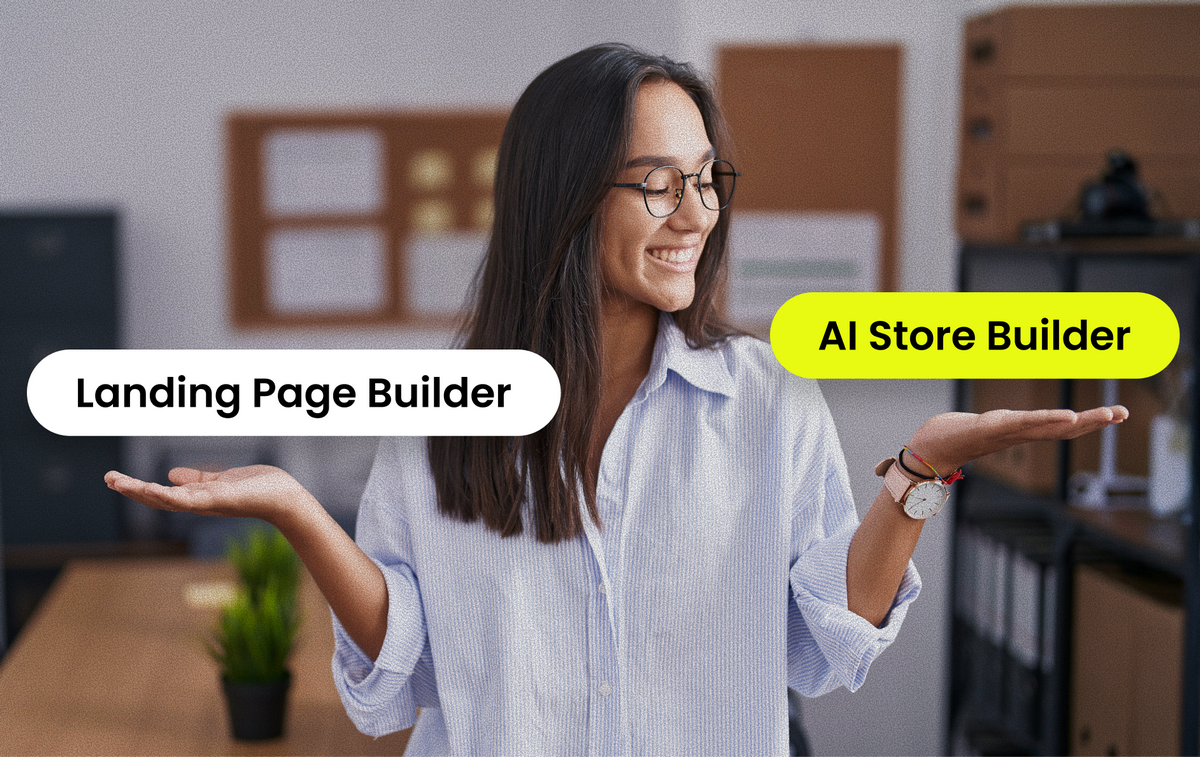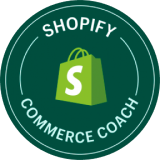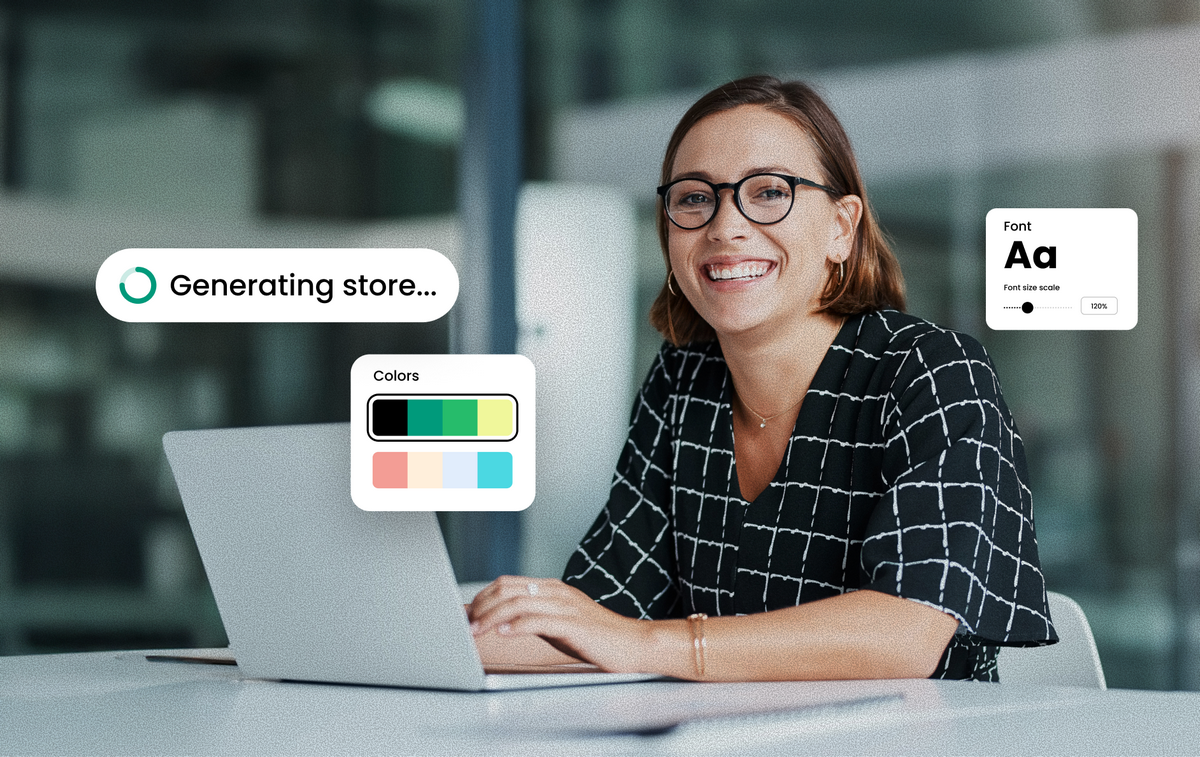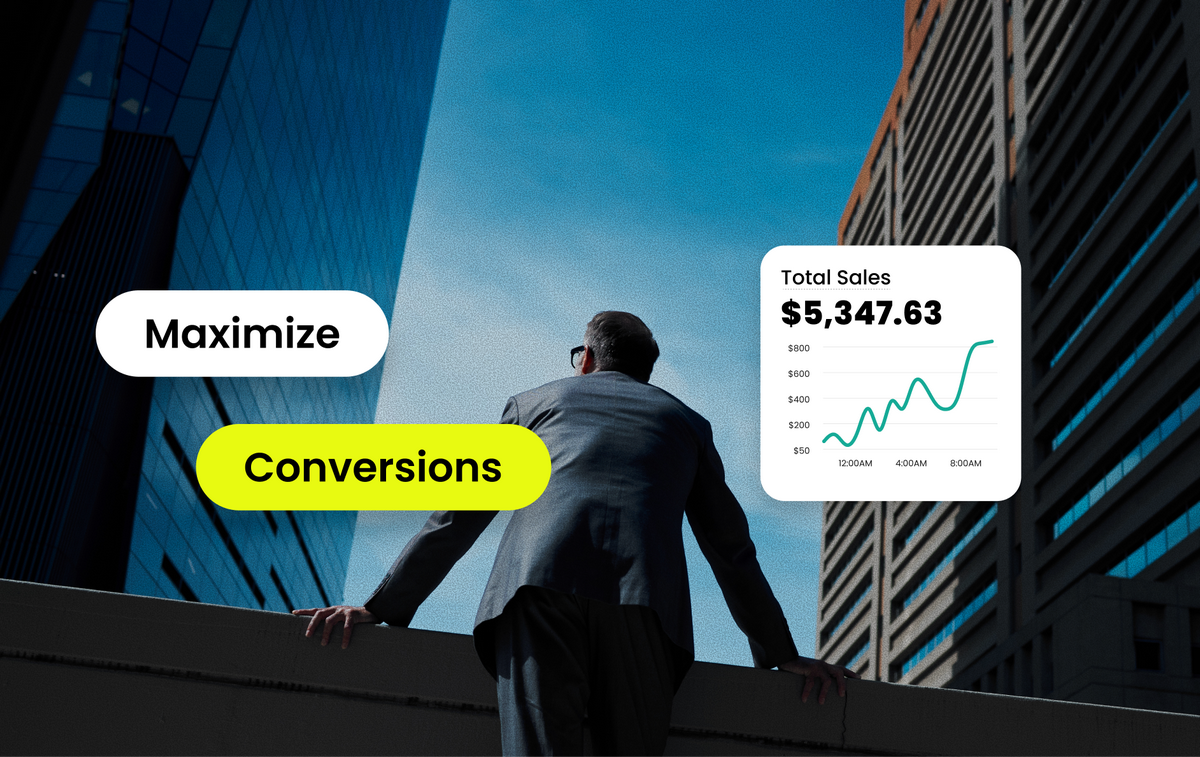Is a complete store overkill, or precisely what you need? For many Shopify entrepreneurs, a single high-converting landing page can validate demand, build an email list, and move product faster than a half-finished catalog.
But as your offer matures, an AI-built, full storefront unlocks cross-sell paths, search visibility, and brand depth you just can’t squeeze into one page.
You’ve got two clear lanes: AI store builders that spin up complete, branded Shopify experiences (navigation, collections, product templates, apps), and AI landing page builders laser-focused on one goal: launching a page that converts with speed and clarity.
Both promise speed; they just solve different problems on different horizons.
In this guide, we’ll make the choice simple. You’ll see when a landing page beats a full store (and vice versa), how leading tools approach copy, design, and data, and a practical way to move from “quick test” to “scalable storefront” without rebuilding everything from scratch.
Full Store vs Single Page: When Each Makes Sense

All the decisions you make in eCommerce are ultimately influenced by personal judgment, your goals, and your experience level (or lack thereof). What you need to remember is the importance of researching before deciding; only then can you choose more confidently.
When you have something to sell, one key decision is choosing between a full store and a single-page store. Each has its own characteristics and specific uses that are worth analyzing beforehand to optimize results in line with your goals and future plans.
A full store offers a variety of products across different categories or niches — even if you only have one product to start with. This diversity lets you test multiple items and capture different customer segments and data. It’s ideal for those seeking flexibility and lower risk, since you’re not relying on a single product to turn a profit.
It also makes cross-selling easier and can attract a broader audience. However, running a full store potentially means handling multiple ad campaigns and coordinating varied inventories, which can be more complex and demand greater marketing experience.
A single-page store, on the other hand, focuses on selling one hero product or a minimal set of related items. This format is especially effective when the product is innovative, has strong impulse-buy potential, or can be clearly positioned in its market.
Single-page stores concentrate all advertising spend and branding effort on that product, that page, which often translates into higher conversion rates and simpler operations.
However, this model carries higher risk since poor performance or low demand for the product can strongly impact the business.
In short, a full store makes sense for those who are getting started or want to diversify their offer with less risk, while a single-page store is recommended for entrepreneurs with experience, a proven product, and the ability to run highly focused marketing.
The ideal approach depends on your budget, market knowledge, and the specific goals of your business.
To summarize
When does a full store make sense?
- When you want flexibility in offering various products and identifying the most profitable ones.
- If you can manage multiple ad campaigns and variable inventories.
- To capture different customer segments, especially at the beginning, which can open cross-sell opportunities.
- It carries less risk of total failure, since you’re not dependent on a single product.
When does a single-page store make sense?
- If the product is highly original or innovative, or has a strong impulse-buy appeal.
- When you have a solid marketing budget, and you can concentrate ad spend on one product to reach the target audience effectively.
- For experienced operators who prefer simpler store management and tightly focused attention on one product.
- It requires deep upfront research to ensure the product has solid demand.
Example Workflows: Store Builders vs Landing Page Builders
Once you start asking whether a Landing Page Builder or a Full-Store AI Builder is the better fit, the underlying build systems come into play.
Sure, you can always hire design and development pros and build a site from scratch, but in the fast-paced world of business, it’s far more convenient to save time and energy with tools that, through a mix of algorithms and AI features, can spin up platforms in minutes. Let’s look at a few examples:
- Build Your Store (BYS): Build Your Store is geared toward entrepreneurs who prefer building a business that doesn’t rely on a single product but on a robust, variable offer, optimizing customer experience and profitability through smart AI features. Build Your Store creates full AI-built Shopify stores in minutes (almost like magic!). You can upload multiple products, create categories, and streamline your workflow to have a full store ready to go from day one.
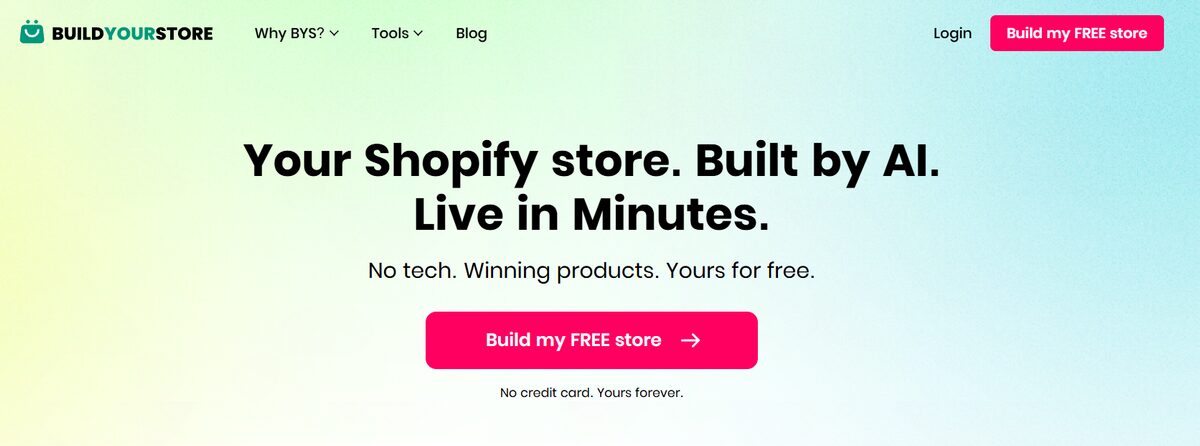
- AutoDS: AutoDS offers a comprehensive dropshipping platform that automates multiple aspects of your business. It lets you automatically import products from a global network of recognized suppliers, including AliExpress, Amazon, CJdropshipping, and more. AutoDS automates order fulfillment and customer tracking updates, saving time and minimizing operational load.
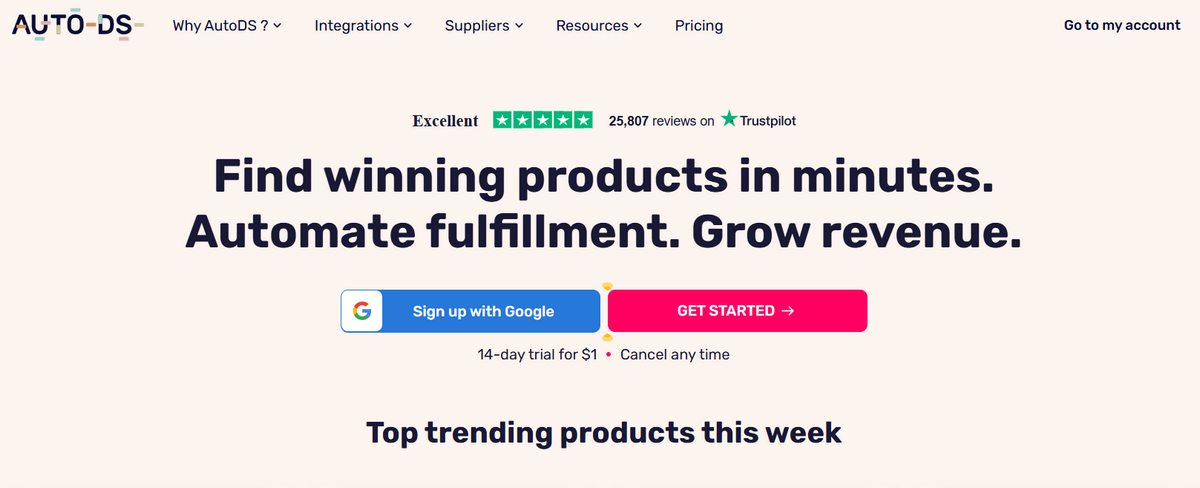
- Zeno AI: It is built to create highly specific, high-converting landing pages. Its drag-and-drop interface, combined with AI capabilities, lets users build effective pages quickly, ideal for single-product campaigns or lead magnets.

- GemPages: Excels at customizable landing pages and funnels integrated with Shopify checkout, making capturing leads and driving conversions for featured products easier.

The workflow with Build Your Store or AutoDS involves loading a broader inventory, developing an organized catalog, and focusing optimizations on retaining repeat traffic and maximizing sales across multiple products.
By comparison, Zeno AI and GemPages are designed to launch precise campaigns, starting with an ad or lead magnet and directing traffic to a tightly focused product page for fast, specific conversions.
Both approaches have value, but AutoDS and BYS stand out for entrepreneurs who want a dropshipping business with broader commercial reach and end-to-end automation.
Build a landing page fast that leaves your competitors’ stores behind, and do it for free! Try Build Your Store now!
Speed vs Depth: Setup vs Customization
As we said above, speed is key in business, and eCommerce is no exception. However, if we want a slightly more complex structure that lets us cover more aspects of the business and scale more deeply, we need to strike a balance.
Landing page builders like Zeno AI or GemPages offer a high-speed setup that can be ready in minutes. They’re perfect for ad campaigns or quick product tests, but have a limited scope; they aren’t designed to handle full operations or large catalogs.
Full-store builders like AutoDS or Build Your Store enable deeper customization, scalable catalog management, and powerful automations that support sustained growth. The best part is, Build Your Store and AutoDS can get a full AI-built store up and running in minutes.
So, if your priority is rapid testing you don’t plan to expand upon, a landing page is a good option; if your goal is scaling and growing, building a full store from the start is a better idea.
In fact, AI store builder tools like Build Your Store help you speed up key processes through innovative features. Take the Shopify Business Name Generator, for example. It accelerates one of the first critical steps in creating a store: choosing a unique, memorable business name.
Converting Visitors: Landing Page Best Practices
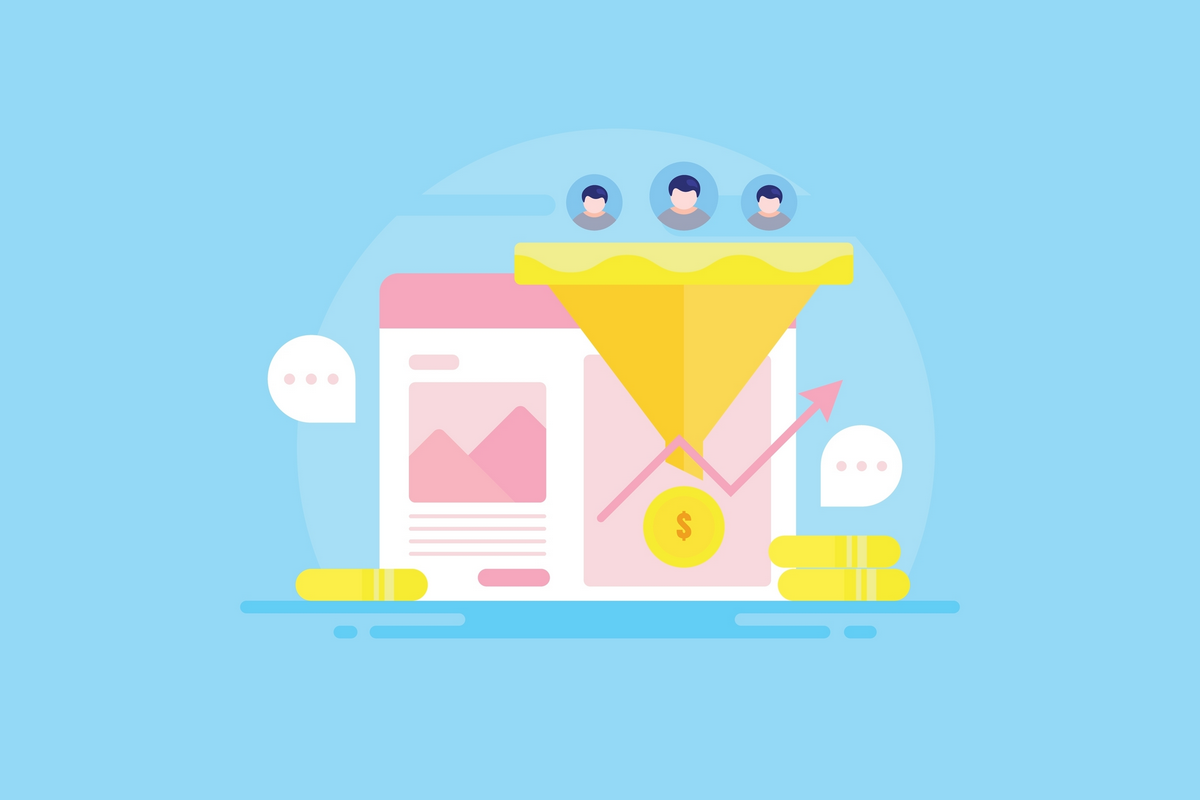
To maximize conversions on landing pages, it’s essential to maintain a clear, singular focus, usually around a single product or offer.
Core elements include strong copy communicating benefits in the headline, trust signals (reviews, guarantees, trust badges), and prominent, optimized calls to action (CTAs).
While some platforms use AI to generate pages quickly, manual refinement is still a good idea to polish these details and ensure credibility and effectiveness. These best practices ensure visitors have a clear, distraction-free path to purchase.
Hybrid Strategies: Lead Magnets + Full Stores
A hybrid strategy that combines the best of both worlds starts with creating a landing page via Zeno or GemPages to capture leads or quickly test products.
When a product proves to be a winner, you scale by integrating it into a full store created by tools like Build Your Store. Connecting that store to AutoDS, which can handle inventory, multiple product listings, and advanced automation, can provide the pathway to sustainable growth.
This approach blends the speed and focus of targeted campaigns with the depth, capacity, and scalability of a complete business, optimizing resources and maximizing sales potential.
Frequently Asked Questions
What’s the difference between a Shopify landing page builder and a store builder?
A store builder (e.g., Build Your Store, AutoDS AI Store Builder) generates a full storefront, navigation, collections, PDP templates, and supports broader merchandising, cross-sell, and content operations. A landing page builder (e.g., Zeno, GemPages) creates a single, conversion-focused page for one offer or lead-generating funnel.
Which AI tool is best for fast product testing?
If you plan to scale and expand your product offerings, Build Your Store can set up a complete AI-built Shopify store in minutes. Landing page builders like Zeno or GemPages let you ship a focused offer and collect clean conversion data on a single product.
Which tool is best for scaling dropshipping stores?
Build Your Store is perfect for getting a dropshipping business off the ground. AutoDS then pairs product research with end-to-end dropshipping automation (product importing, pricing/stock sync, and order fulfillment), making it ideal for long-term growth.
Can I use both a landing page builder and a store builder?
Absolutely. Many sellers validate on a landing page first, then promote the winners into a complete Shopify store to unlock cross-sells, SEO, and retention.
Do AI landing page builders handle payments?
Yes. They plug into Shopify Checkout for payments. However, they don’t manage extensive catalogs or supplier automation the way complete solutions like AutoDS do.
Conclusion
Choosing between AI full-store builders and landing page builders might seem straightforward, but it involves strategic considerations that can shape the success of your dropshipping business.
Fortunately, these tools serve different purposes: landing pages let you test quickly and capture customers with highly targeted angles, while full-store builders like Build Your Store and AutoDS offer scalability, automation potential, and the depth needed to manage complete catalogs.
Remember: striking the right balance between speed and depth can be the difference between launching successful campaigns today and scaling your business tomorrow.
For more strategies and tips, check out our blog:

